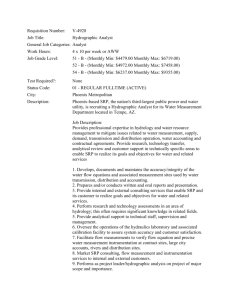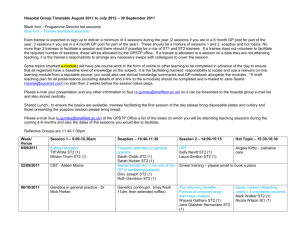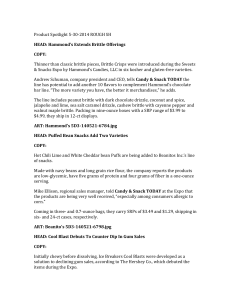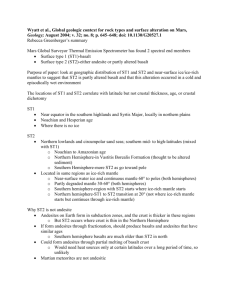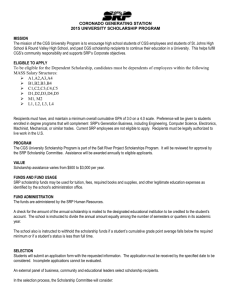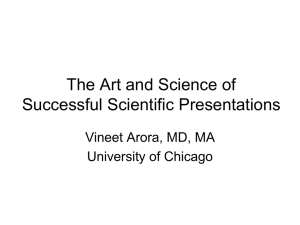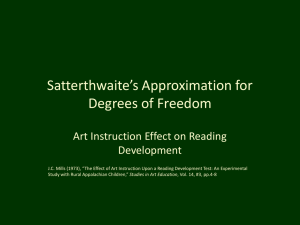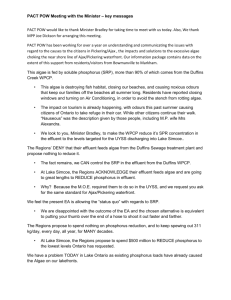File - western undergrad. by the students, for the students.
advertisement
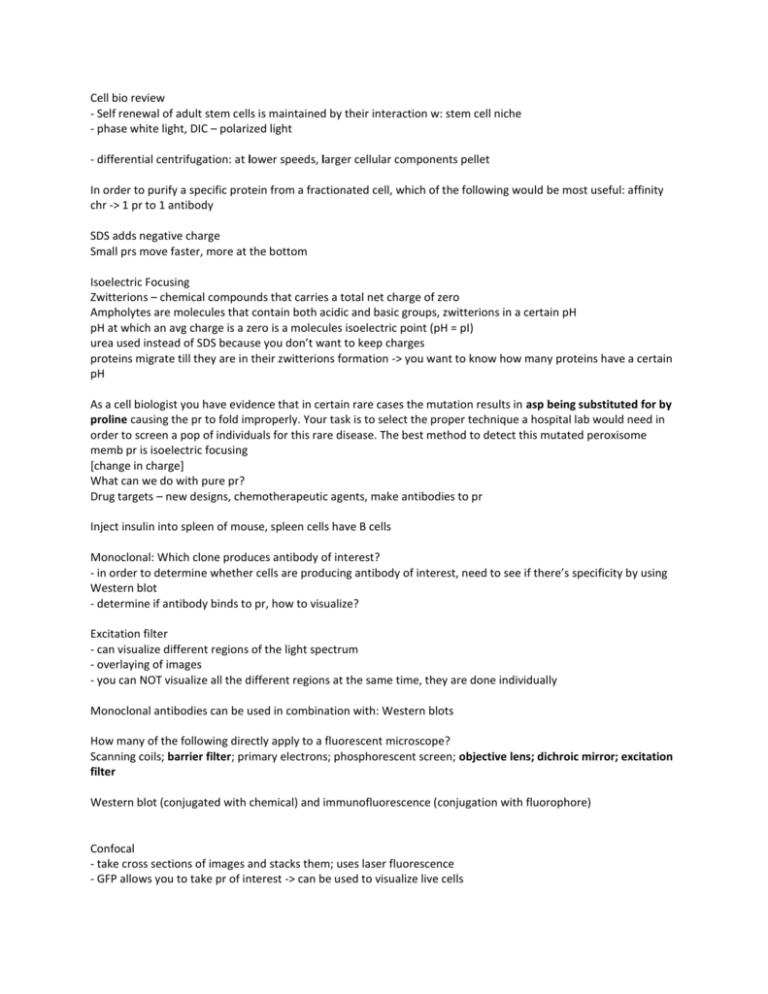
Cell bio review - Self renewal of adult stem cells is maintained by their interaction w: stem cell niche - phase white light, DIC – polarized light - differential centrifugation: at lower speeds, larger cellular components pellet In order to purify a specific protein from a fractionated cell, which of the following would be most useful: affinity chr -> 1 pr to 1 antibody SDS adds negative charge Small prs move faster, more at the bottom Isoelectric Focusing Zwitterions – chemical compounds that carries a total net charge of zero Ampholytes are molecules that contain both acidic and basic groups, zwitterions in a certain pH pH at which an avg charge is a zero is a molecules isoelectric point (pH = pI) urea used instead of SDS because you don’t want to keep charges proteins migrate till they are in their zwitterions formation -> you want to know how many proteins have a certain pH As a cell biologist you have evidence that in certain rare cases the mutation results in asp being substituted for by proline causing the pr to fold improperly. Your task is to select the proper technique a hospital lab would need in order to screen a pop of individuals for this rare disease. The best method to detect this mutated peroxisome memb pr is isoelectric focusing [change in charge] What can we do with pure pr? Drug targets – new designs, chemotherapeutic agents, make antibodies to pr Inject insulin into spleen of mouse, spleen cells have B cells Monoclonal: Which clone produces antibody of interest? - in order to determine whether cells are producing antibody of interest, need to see if there’s specificity by using Western blot - determine if antibody binds to pr, how to visualize? Excitation filter - can visualize different regions of the light spectrum - overlaying of images - you can NOT visualize all the different regions at the same time, they are done individually Monoclonal antibodies can be used in combination with: Western blots How many of the following directly apply to a fluorescent microscope? Scanning coils; barrier filter; primary electrons; phosphorescent screen; objective lens; dichroic mirror; excitation filter Western blot (conjugated with chemical) and immunofluorescence (conjugation with fluorophore) Confocal - take cross sections of images and stacks them; uses laser fluorescence - GFP allows you to take pr of interest -> can be used to visualize live cells TEM - take tissue sample, treat with heavy metals - cathode accelerates primary electrons and hits specimen - image on phosphorescent screen - where heavy metal has not been incorporated, penetrates thru sample i.e. cytoplasm, gives image in WHITE - where metal has not penetrated shadow i.e. nucleus - with TEM, no refractive index -> better resolution SEM - primary electrons to scanning coil - scanning coils shake up electron path - secondary electrons hit specimen on correct angle which is captured on detector Covalently attach antibodies, molecules, aa to gold particles and attach them into live cells - use heavy metals with techniques to identify cellular components, can be combined with TEM How many of the following would I need and/or be required to generate this micrograph? Primary electrons;phosphorescent screen; heavy metals; fluorochromes; UV light; secondary electrons; X-ray film; monoclonal antibodies; electromagnetic lenses 4 Monoclonal antibodies can be used in combination with TEM to determine identify subcellular localization of prs What DNA microarrays arrays: global gene expr - want to compare treatment v. control mRNA -> cDNA fluorescenty label with colour 1. Each well contains DNA oligonucelotides specific to one gene 2. Add mixture of fluorescently labelled cDNA from both control and cancer 3. Visualize under fluorescent microscopy One pieces of DNA, single stranded! Take chip, expose to fluorescent microscopy - reporter gene allows us to detect change - activator allows RNAP recruitment - two physically and functionally distinct domain The final screen using yeast 2 hybrid cloning to detect pr:pr interactions requires that the recombinant yeast cells: Plate on medium lacking His EMSA - detecting DNA:pr interactions - how do you determine that promoter region can participate in transcription of that gene? - take radioactively labelled oligonucleotide and incubate with nuclear extract -> run on gel - pr finds target which increases its mass and decreases its mobility (so it’s slower) - at this point, you only know that a protein binds to radioactive probe - now take antibody and if it binds, creates supershift - now repeat experiments with all the putative sites to confirm that you have a certain specific TF -secreted & membrane proteins are sorted through RER SRP binds, translation halted - to start translation again, you need to release SRP - SRP receptor is in embedded in ER No SRP, no GTP, no SRP receptor - complete polypeptide + signal sequence Exp 2: SRP added - signal sequence translated, SRP recognizes and binds to it, translation halted - no way for SRP to release signal sequence - all you see is 25-50 aa Exp 3: SRP, SRP receptor added and GTP - SRP binds SRP receptor - GTP hydrolyzed -> SRP can let go of SRP receptor - see complete polypeptide + signal sequence Exp 4: add microsomes, small intact pieces of RER - signal sequence cleaved off, pr of correct size -> complete polypeptide 3 diff sizes of polypeptides can be produced You are testing polypeptide modification during translation and have the following at your disposal: cell free system and microsomes; a 600 nucleotide mRNA; GTP, S-met and all other aa and SRP receptors. Using SDS-PAGE and techniques to detect PULSE CHASE Secretory cells Pulse: radiolabelled aa: all prs made during that time will be labelled Chase: unlabelled aa - now all new prs made will NOT be labelled - fix cells at diff time points and use autoradiography to visualize location of prs in the cell - can follow mvt of one group of prts through the cell - allows you determine direction - only prs made in a certain period of time are labelled Get scurvy if you don’t have proper hydroxylation (due to insufficient vit c) COPII prs coat M6P is another targeting signal - M6P targets proteins to lysosome - lysosomal enzymes need to get to lysosome so it needs M6P signal on it - sugar phosphotransferase is only found in cis golgi and adds P onto mannose for a proper M6P signal Which is correct transport route of a pr that sits on the surface of your RBC? ER, cis, med, trans, placement in plasma membrane Only SRP relates to secreted prs RME - a method of selective internalization (one specific pr) - LDL receptors recognize ApoB (coats LDL) - clathrin helps form structure of internalizing - CURL has low pH - receptor shuttled back to plasma membrane - ferretin contains iron and allows you to visualize LDL - clathrin coat dissociates inside, vesicle goes to lysosome and ApoB degraded - constitutive: fibroblast secreting collagen - regulated: prs synth and stored in secretory vesicles until told to be secreted i.e. insulin At 35 degrees, yeast should divide Functional complementation: if yeast get WT copy of gene, then cells can divide again at 35 degree Mutating cdc2 prevents cells from going from G2 to mitosis - cdc2 encodes pr kinase (p34) cdcD (dom) -> cells will divide prematurely and you end up with smaller cells p 34 needs to work with cyclin make up MPF ubiquitin ligase recognizes destruction box and adds ubiquitin (polyubiquitination) - pr sent to proteosome which degrades pr - cyclin degraded in anaphase -> no longer active MPF and cell kicked out of mitosis
